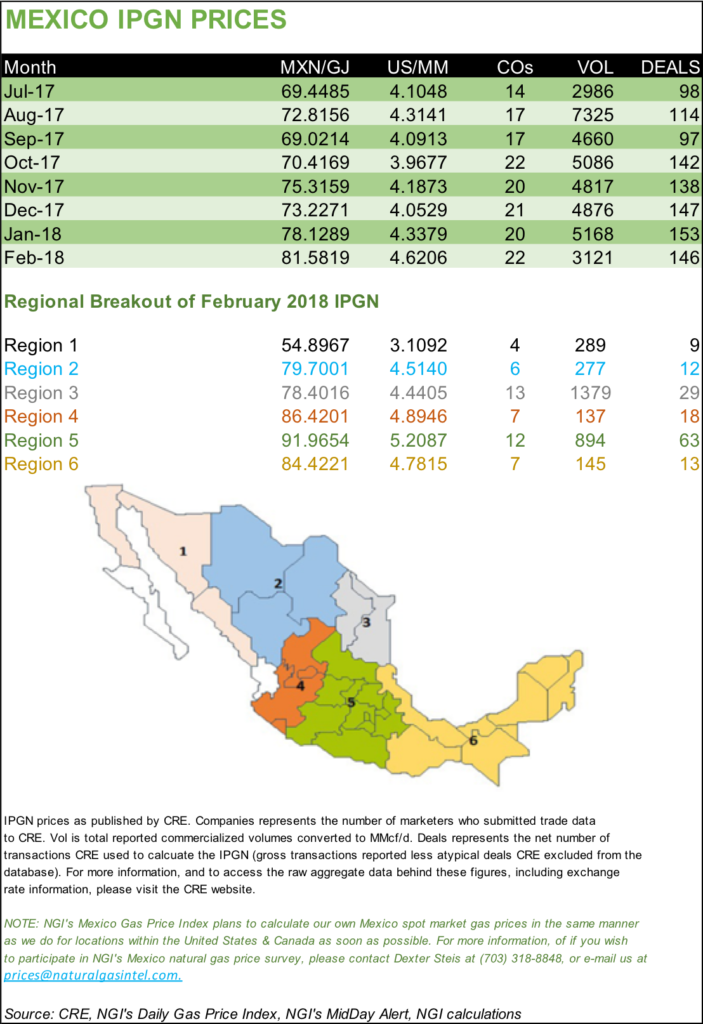CRE Publishes February Natural Gas Prices for Six Mexico Regions
The Mexican energy regulator on Tuesday afternoon published, for the first time, monthly natural gas prices for six trading regions in the country.

The prices, which correspond to February, ranged from 54.897 pesos/gigajoule(GJ) in the northwest Region 1 to 91.965 pesos/GJ in the central Region 5, or $3.109/MMBtu to $5.209/MMBtu, according to the Comision Reguladora de Energia (CRE).
The national average for the month was 81.582 pesos/GJ ($4.621/MMBtu), compared to 78.129 pesos/GJ (US$4.338/MMBtu) in January.
CRE calculates its prices using data collected from the monthly post-transaction reports that are mandatory for all natural gas marketers operating in Mexico. The resulting indices show an average price, combining the price per molecule and transport costs, for all trades billed in each region during the previous month.
During February, 22 marketers reported 153 trades for a total volume of 87.4 Bcf, according to the regulator. CRE excluded seven statistically atypical trades before calculating the final prices.
The regulator unveiled last month the six trading regions, which it designed based on supply patterns, Mexico’s pipeline infrastructure, and the prices and volumes reported in each state, among other factors. The six areas encompass the Federal District and all but two of Mexico’s 31 states, with regions 1-3 covering the northern half of the country and regions 4-6 covering its central and southern states.
Region 5, which reported the highest average price for February, also recorded the most deals for the month. A total of 12 marketers billed 68 transactions for a combined volume of 25 Bcf.
Located in central Mexico, Region 5 encompasses some of Mexico’s most densely populated areas, including Mexico City. The Los Ramones system, carrying gas imports from South Texas, terminates in this region, where it links up with other pipelines on the national Sistrangas network.
By volume, northeast Mexico saw the most trading activity. In Region 3, marketers reported 30 transactions for a total of 38.6 Bcf, or 44.2% of all volumes billed during February. The average price of those trades was 78.402 pesos/GJ ($4.441/MMBtu).
Region 3 covers the industrialized states of Nuevo Leon and Tamaulipas. Gas imports from South Texas flow into this region at numerous border crossing points, including NET Mexico at Rio Grande, TX, which accounts for just under half of all U.S. pipeline shipments into Mexico. The NET Mexico pipeline interconnects with the Los Ramones system at Camargo on the Mexican side of the border.
Most of the pipelines in Region 3 are part of the Sistrangas, but it also includes Kinder Morgan Inc.’s Mier-Monterrey, which terminates near the Nuevo Leon capital of Monterrey. Also in Monterrey, the Nueva Era cross-border pipeline, a joint-venture between Howard Energy Partners and Mexico’s Grupo Clisa, is due in service later this year.
The northwest Region 1, which saw the lowest average price for February, also reported the fewest transactions. Four marketers billed nine deals for total monthly trading volume of 8.1 Bcf.
The region includes the Sonora pipeline, which runs from the Arizona border down the coast of the Sea of Cortez into Sinaloa state. Since August, a force majeure on the pipeline’s Guaymas-El Oro segment, the result of a social conflict, has curtailed shipments from the Sasabe, AZ border crossing. The isolated Naco-Hermosillo and Baja California systems are also located in Region 1.
In Region 2, private pipelines connected to West Texas imports points and the northwest section of Sistrangas converge near El Encino in Chihuahua state. There have been delays to several Mexican pipelines that would move gas imports from the Waha hub downstream into this region, but most are expected to come in service by the end of this year or early 2019.
Six marketers billed 13 transactions in Region 2 for a total trading volume of 7.8 Bcf and an average price of 79.700 pesos/GJ ($4.514/MMBtu). Region 4 in southwest Mexico, with 3.8 Bcf, and Region 6 in the southeast, with 4 Bcf, had the smallest volumes reported for February.
In August last year, CRE began publishing a national version of the monthly index, known as the IPGN. At the time, officials said the regulator would begin releasing regional prices once it had collected enough transaction data to identify specific trading areas and liquidity points within Mexico.
The regulator also plans to create a set of forward-looking price indexes, using data culled from the daily trading reports that Mexican marketers are also required to file. These are to include a daily index that would show the average price of all trades scheduled for next-day flow, as well as a monthly index of trades with flow dates on the following month.
Like with the IPGN, the CRE expects to first publish national version of these indexes and eventually roll out regional prices.
The CRE indexes, also known as price reports, are intended to be indicative and temporary. Officials have said they expect to cease publication once the market is able to develop indexes on its own.
Currently, most trades in the Mexican gas market are priced with U.S. indexes like Henry Hub and Houston Ship Channel, plus the cost of transport.
Last year, Mexico imported around 5 Bcf/d to supply 62% of national gas demand, which averaged 8.07 Bcf/d, according to the Energy Ministry (Sener). Pipelines delivered 4.36 Bcf/d of Mexican gas imports in 2017, while the remaining 643 MMcf/d came from two of the country’s liquefied natural gas (LNG) terminals.
The Altamira LNG terminal is located on the Gulf Coast in Tamaulipas, near the border between the CRE’s regions 3 and 6 and not far from central Region 5. The Manzanillo terminal is on the Pacific Coast in the state of Colima, which is part of Region 4. A third LNG import facility in Baja California, in Region 1, has not received any cargos since mid-2016.
© 2024 Natural Gas Intelligence. All rights reserved.
ISSN © 2577-9877 | ISSN © 2577-9966 |
